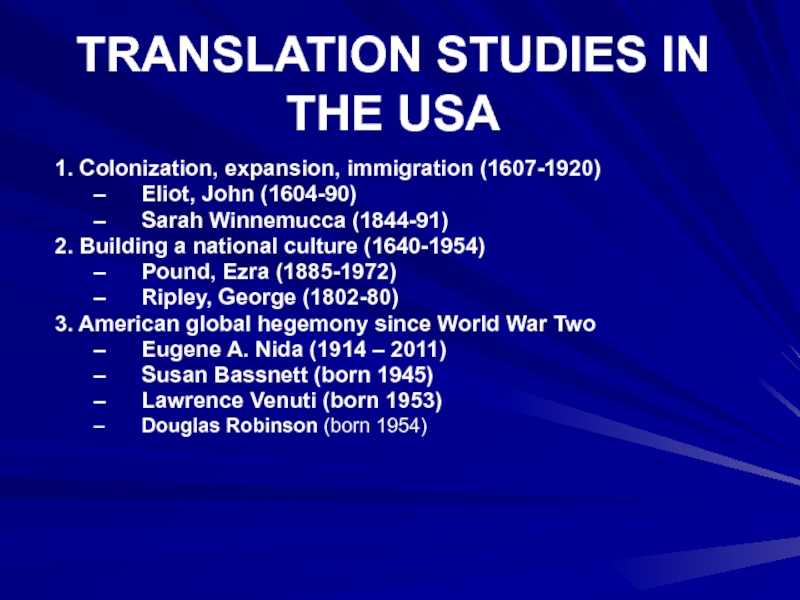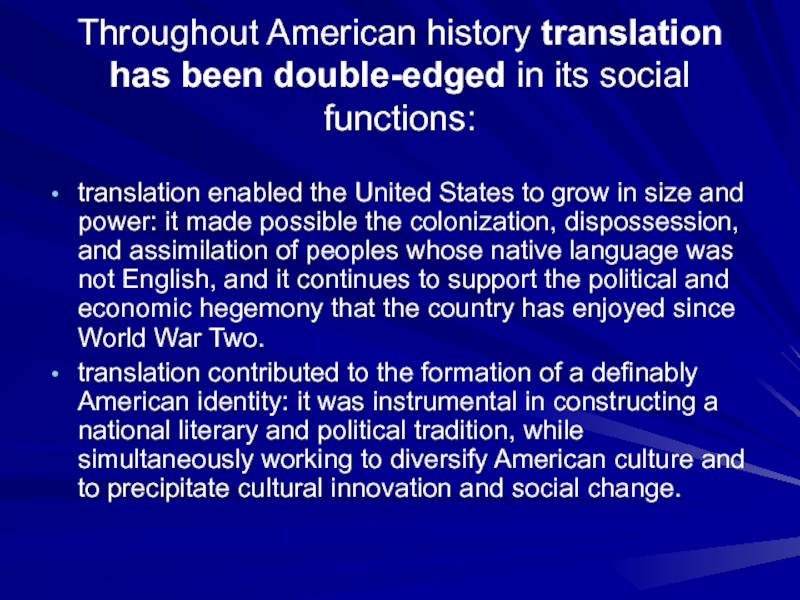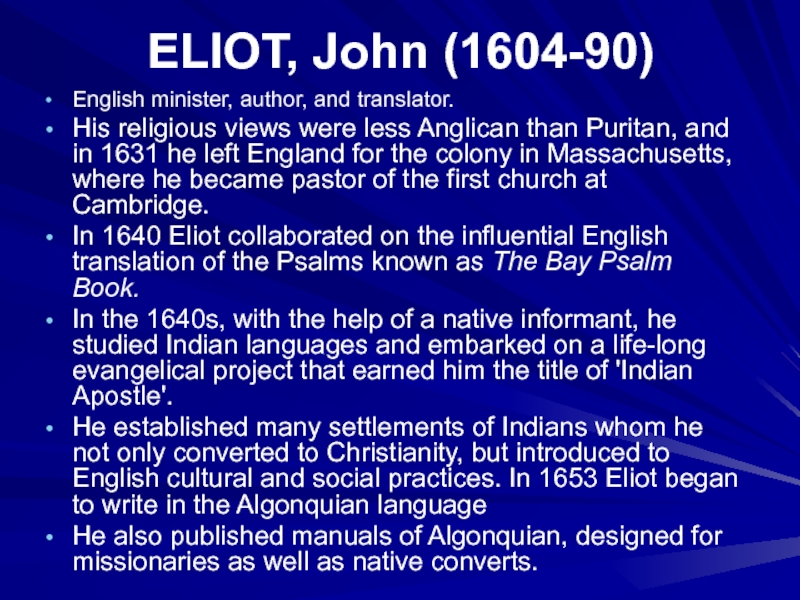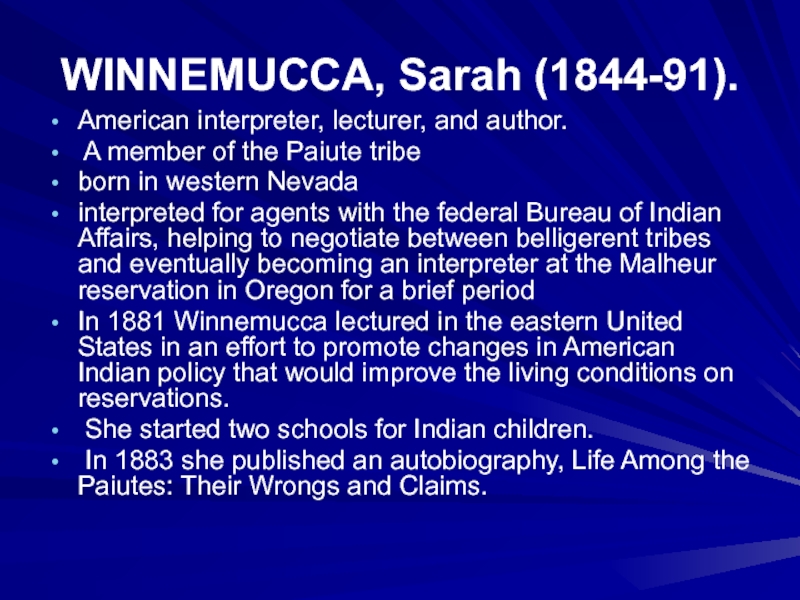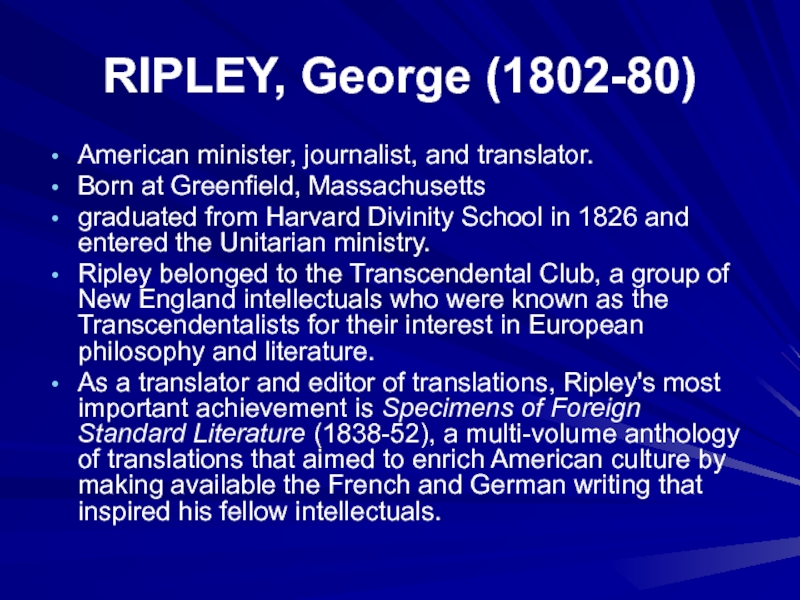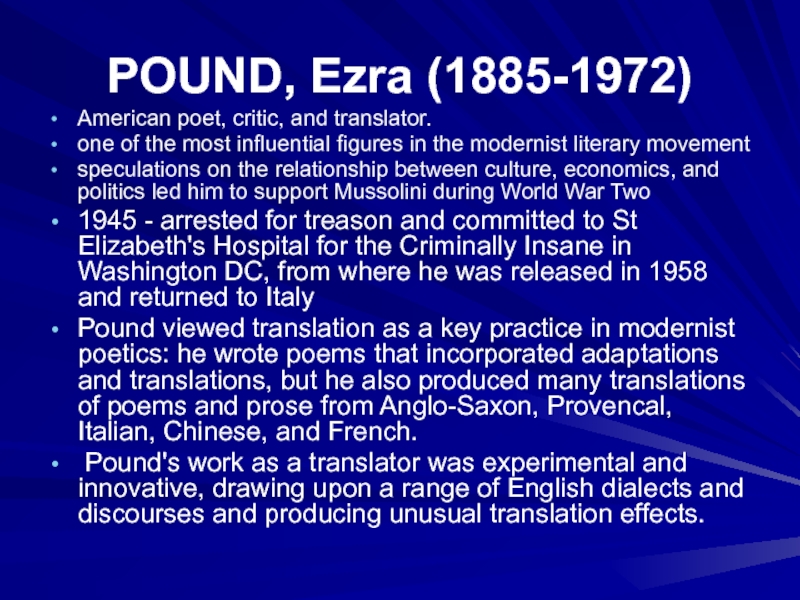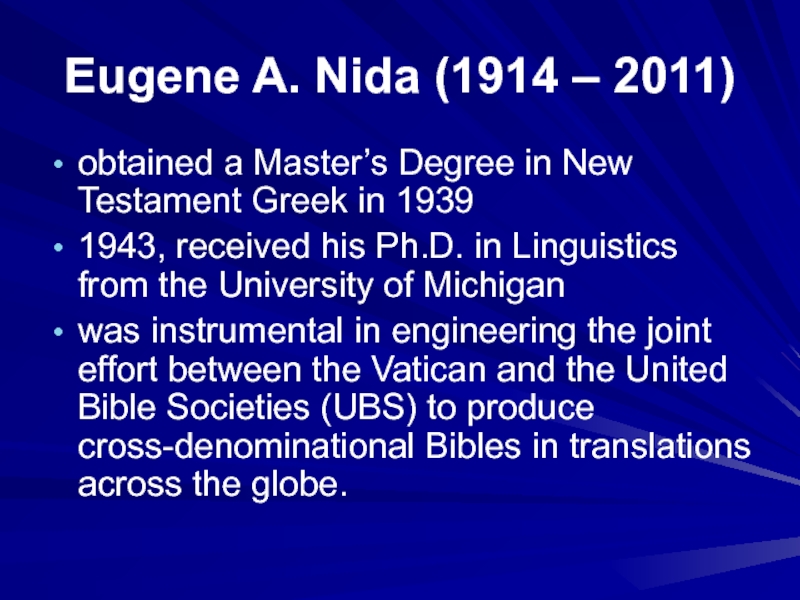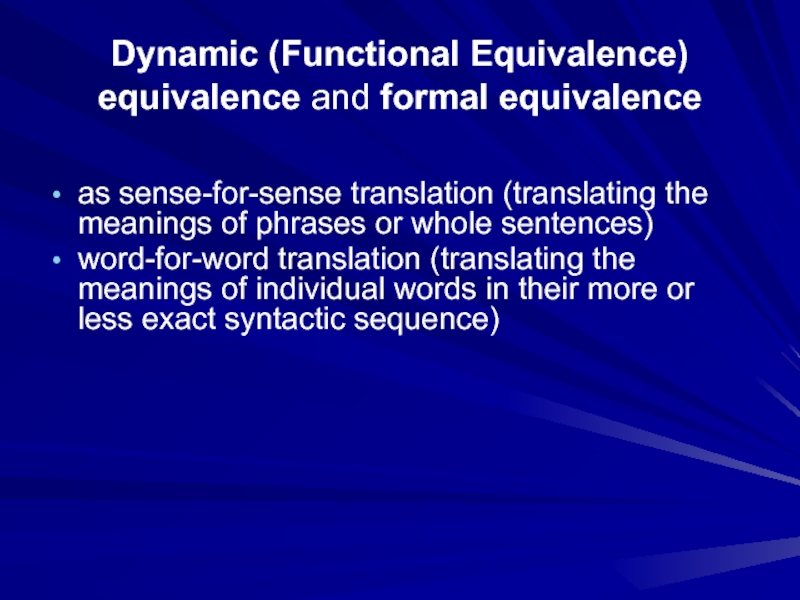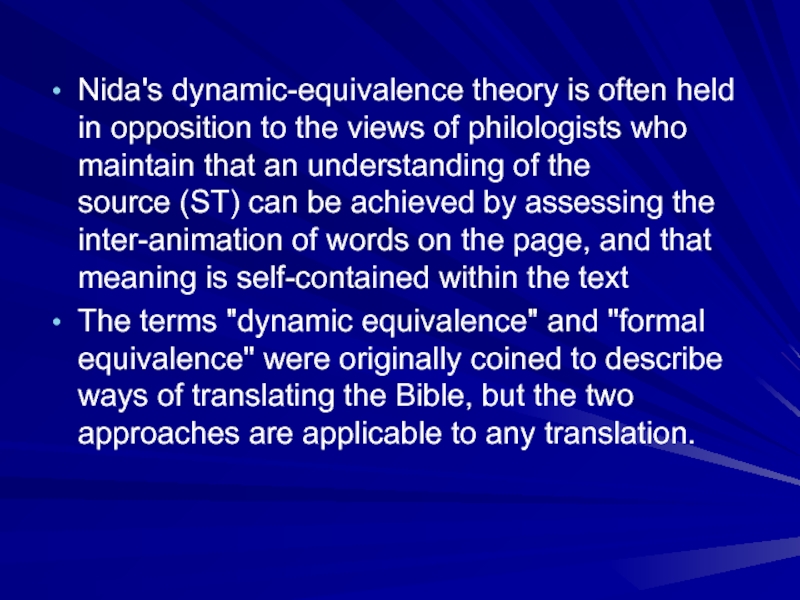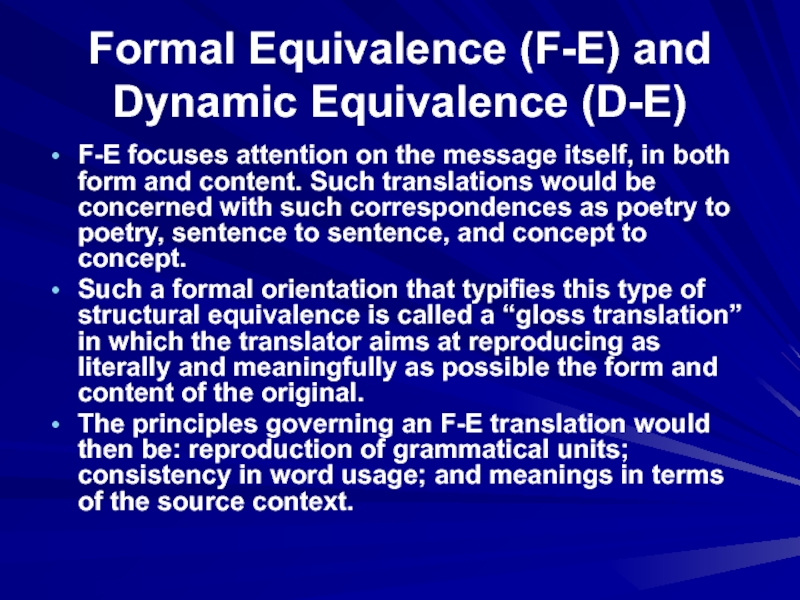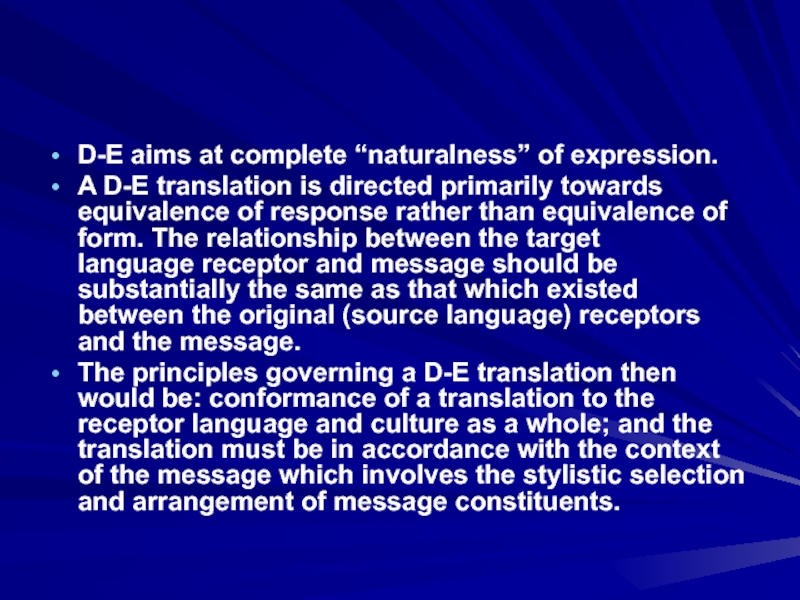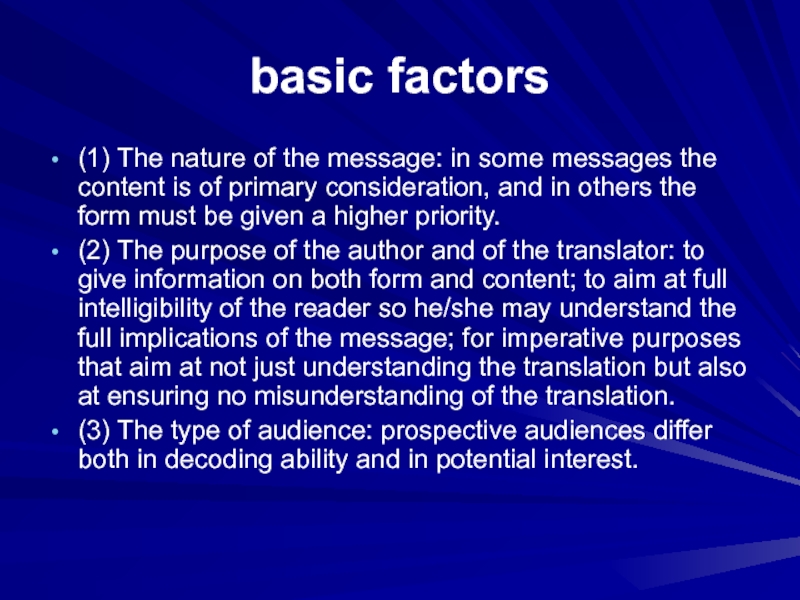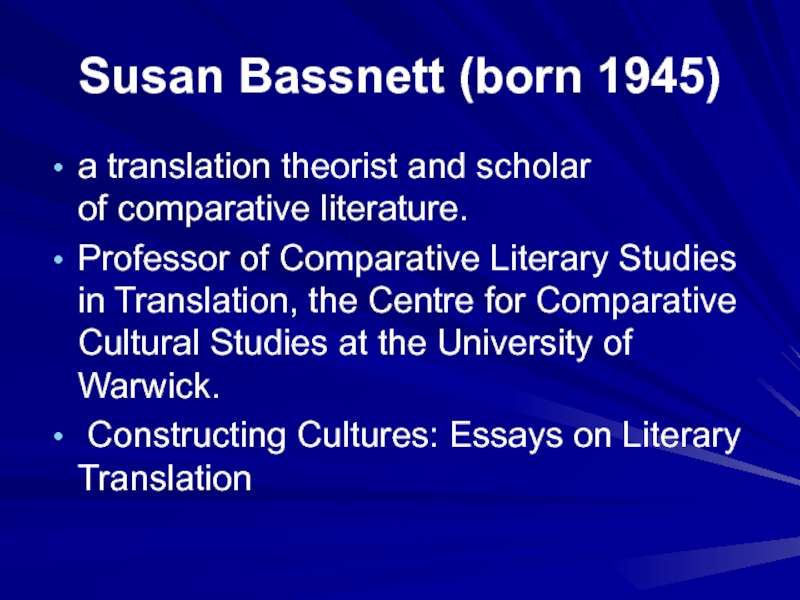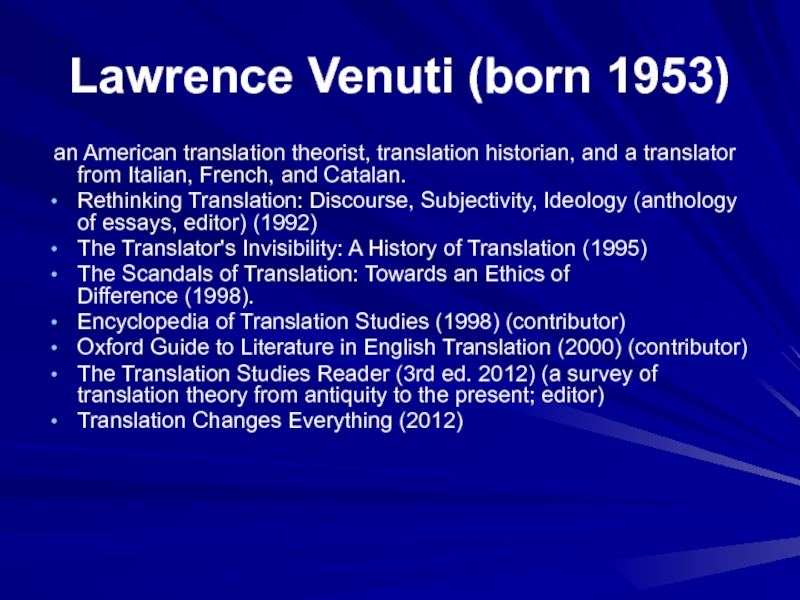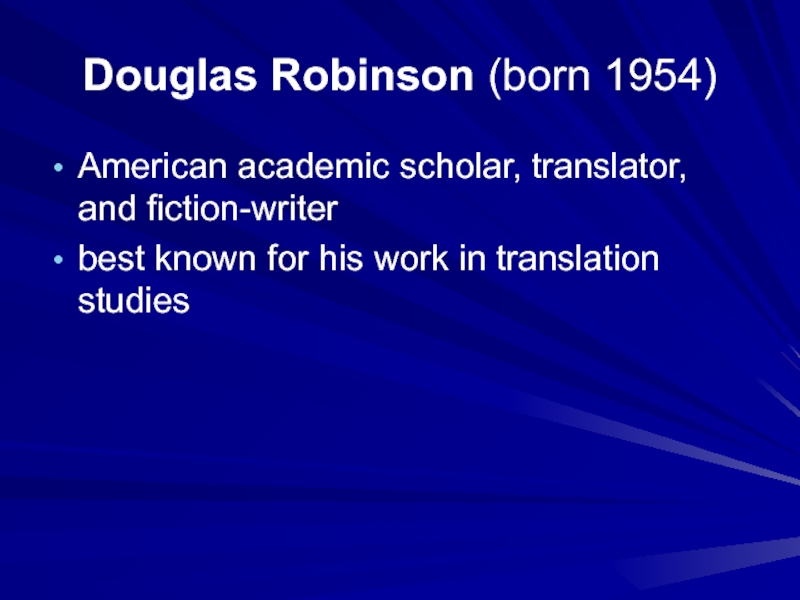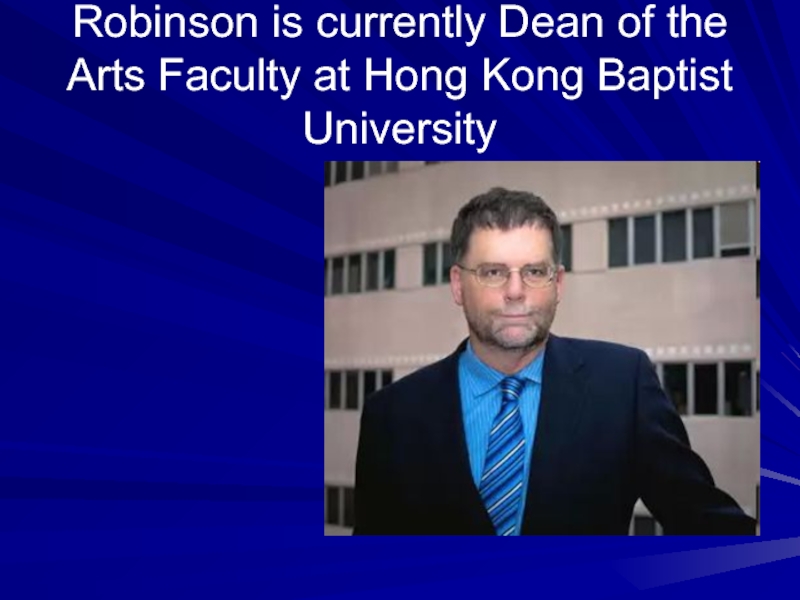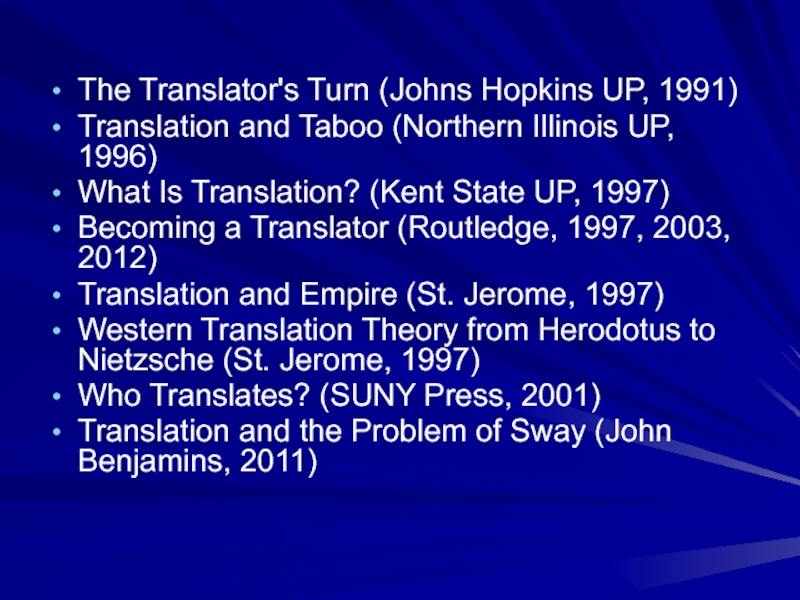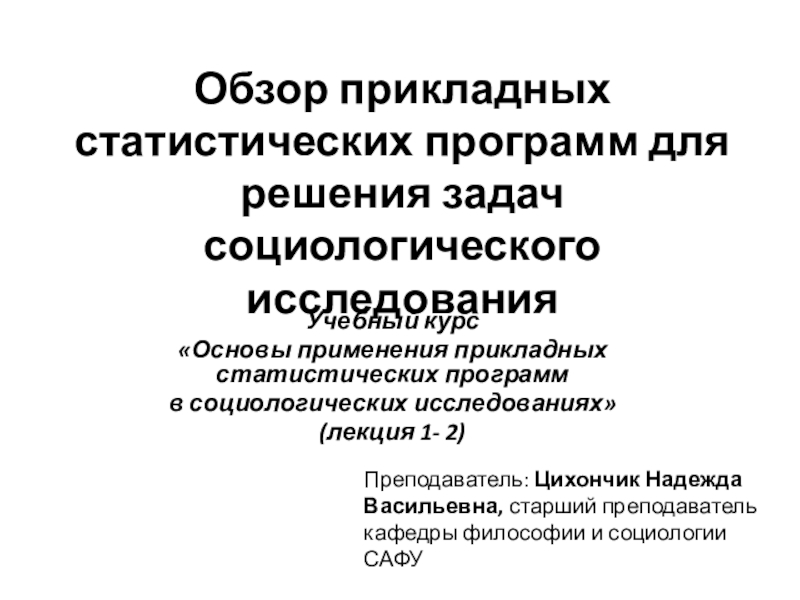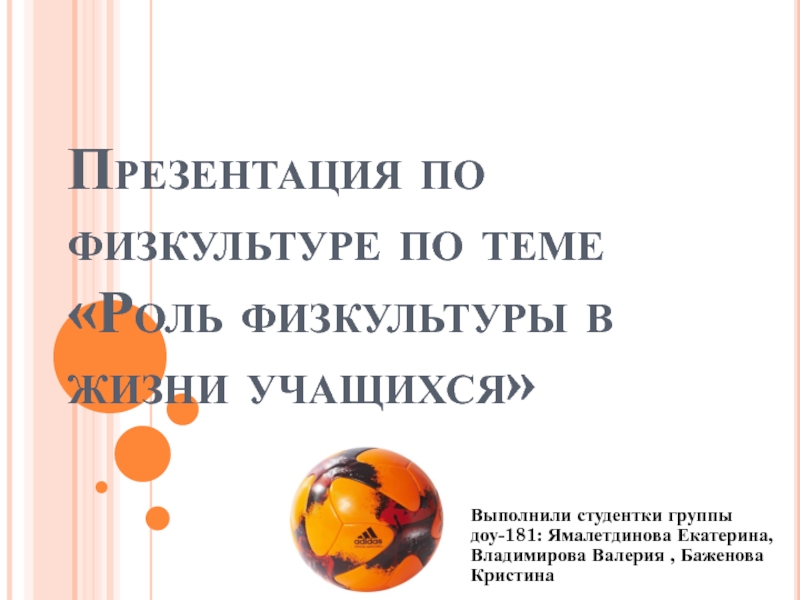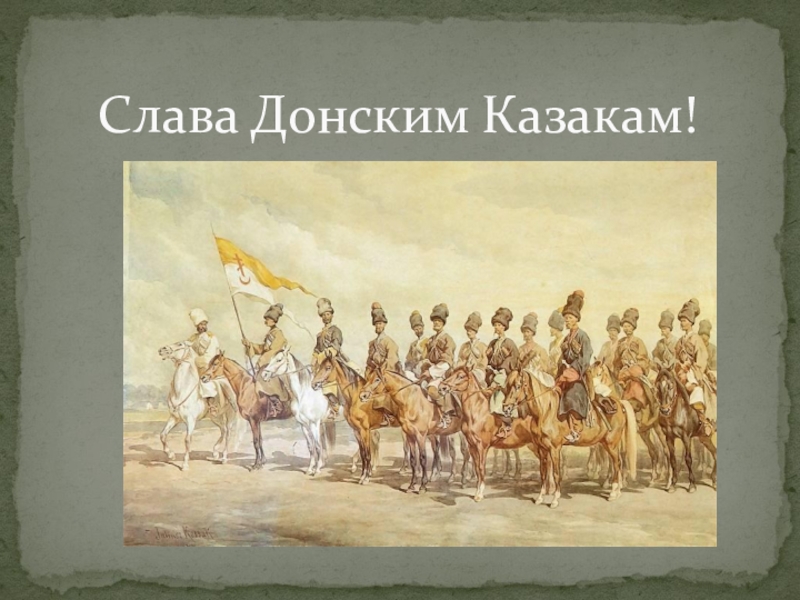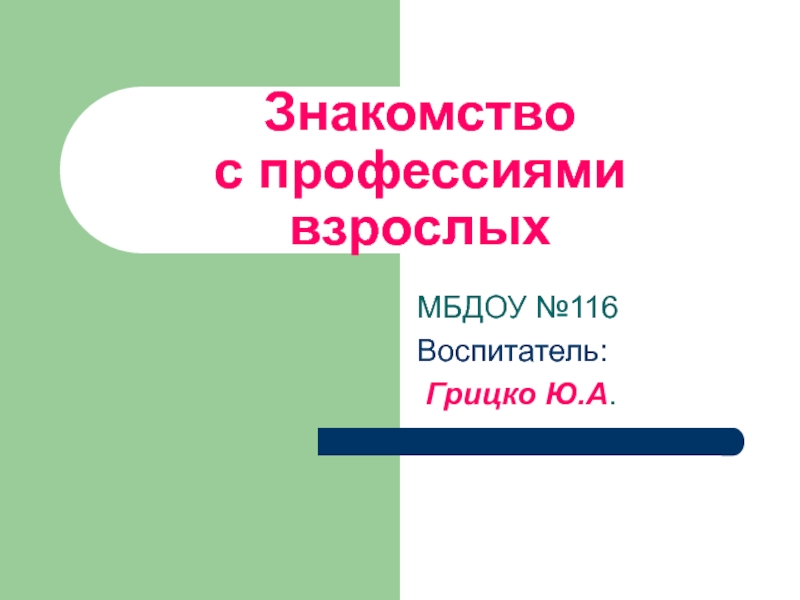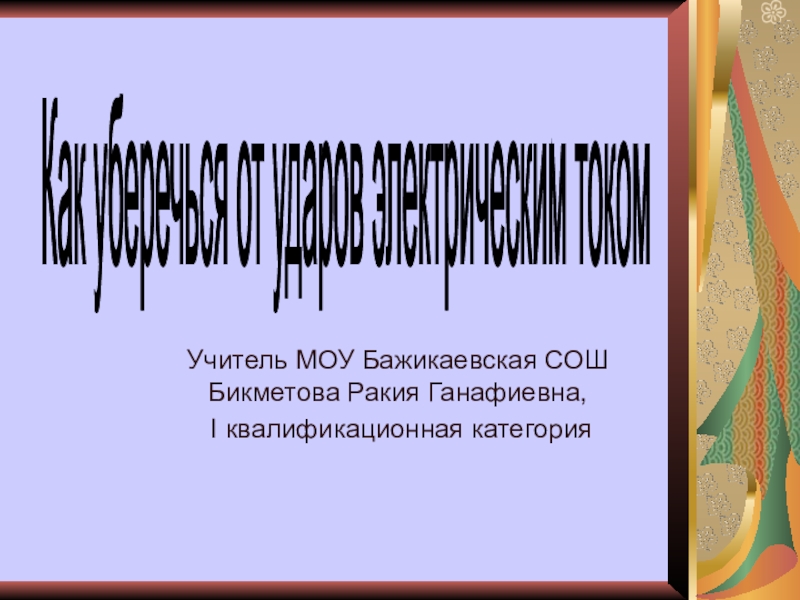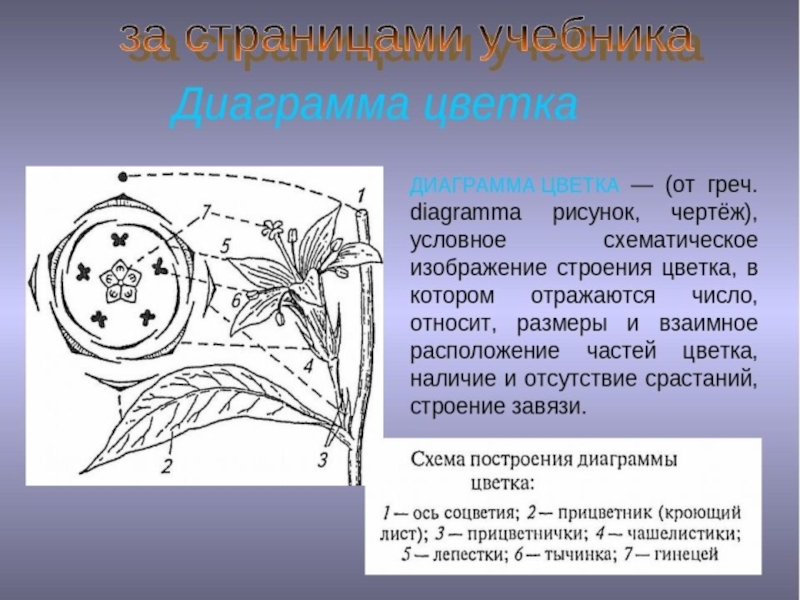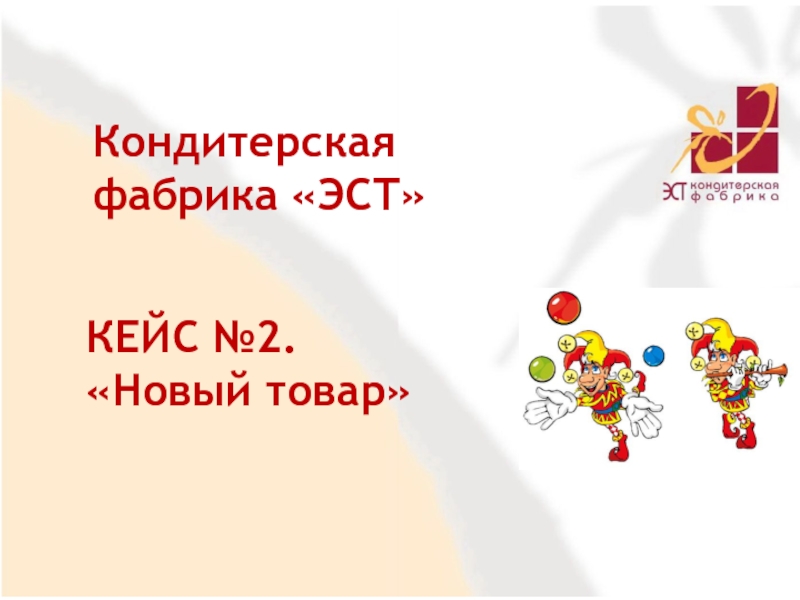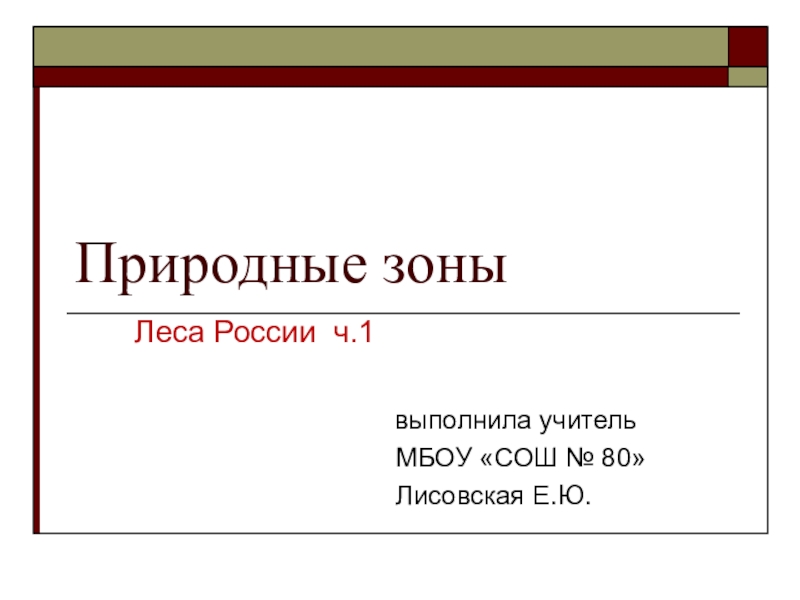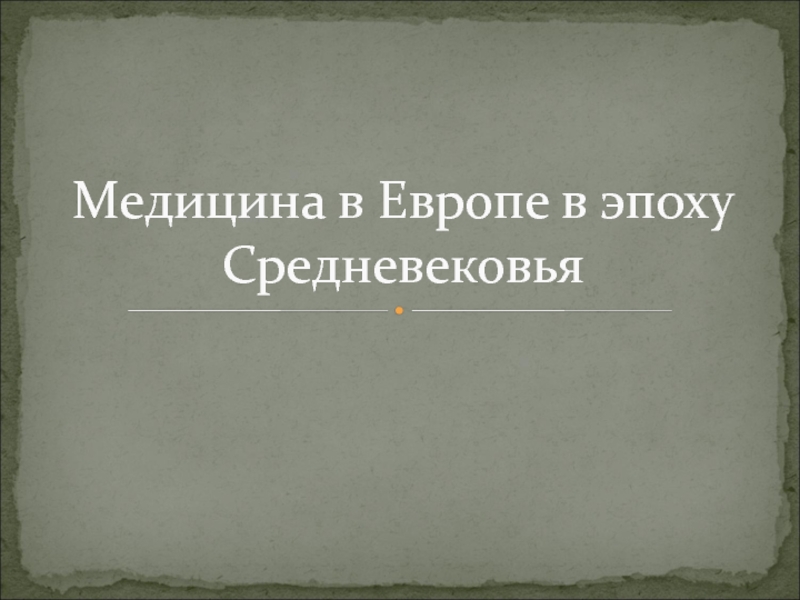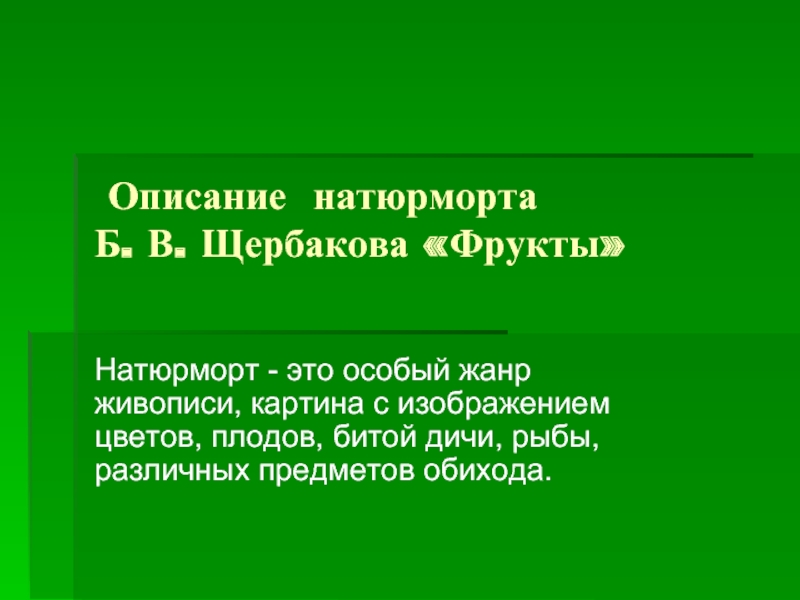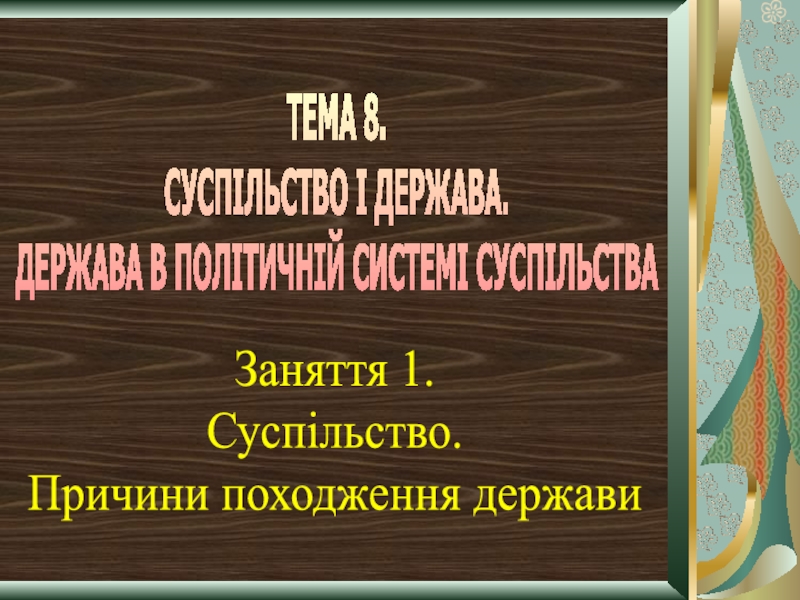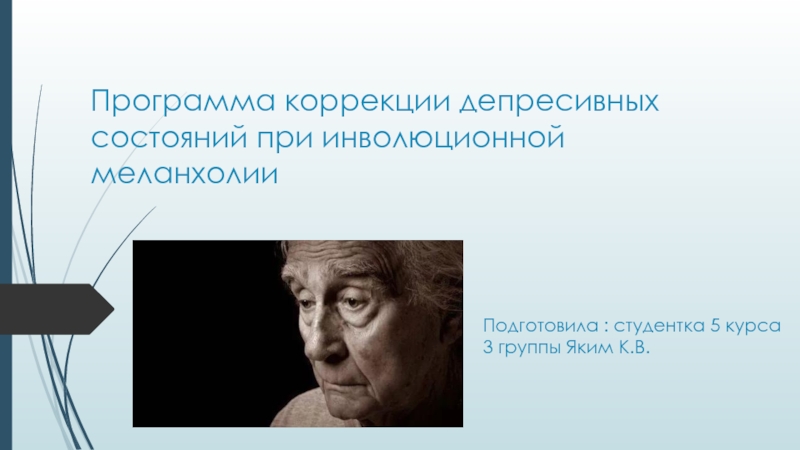Слайд 1TRANSLATION STUDIES IN THE USA
1. Colonization, expansion, immigration (1607-1920)
Eliot, John
(1604-90)
Sarah Winnemucca (1844-91)
2. Building a national culture (1640-1954)
Pound, Ezra (1885-1972)
Ripley,
George (1802-80)
3. American global hegemony since World War Two
Eugene A. Nida (1914 – 2011)
Susan Bassnett (born 1945)
Lawrence Venuti (born 1953)
Douglas Robinson (born 1954)
Слайд 2Throughout American history translation has been double-edged in its social
functions:
translation enabled the United States to grow in size and
power: it made possible the colonization, dispossession, and assimilation of peoples whose native language was not English, and it continues to support the political and economic hegemony that the country has enjoyed since World War Two.
translation contributed to the formation of a definably American identity: it was instrumental in constructing a national literary and political tradition, while simultaneously working to diversify American culture and to precipitate cultural innovation and social change.
Слайд 3ELIOT, John (1604-90)
English minister, author, and translator.
His religious views
were less Anglican than Puritan, and in 1631 he left
England for the colony in Massachusetts, where he became pastor of the first church at Cambridge.
In 1640 Eliot collaborated on the influential English translation of the Psalms known as The Bay Psalm Book.
In the 1640s, with the help of a native informant, he studied Indian languages and embarked on a life-long evangelical project that earned him the title of 'Indian Apostle'.
He established many settlements of Indians whom he not only converted to Christianity, but introduced to English cultural and social practices. In 1653 Eliot began to write in the Algonquian language
He also published manuals of Algonquian, designed for missionaries as well as native converts.
Слайд 4WINNEMUCCA, Sarah (1844-91).
American interpreter, lecturer, and author.
A member of
the Paiute tribe
born in western Nevada
interpreted for agents with the
federal Bureau of Indian Affairs, helping to negotiate between belligerent tribes and eventually becoming an interpreter at the Malheur reservation in Oregon for a brief period
In 1881 Winnemucca lectured in the eastern United States in an effort to promote changes in American Indian policy that would improve the living conditions on reservations.
She started two schools for Indian children.
In 1883 she published an autobiography, Life Among the Paiutes: Their Wrongs and Claims.
Слайд 5RIPLEY, George (1802-80)
American minister, journalist, and translator.
Born at Greenfield, Massachusetts
graduated
from Harvard Divinity School in 1826 and entered the Unitarian
ministry.
Ripley belonged to the Transcendental Club, a group of New England intellectuals who were known as the Transcendentalists for their interest in European philosophy and literature.
As a translator and editor of translations, Ripley's most important achievement is Specimens of Foreign Standard Literature (1838-52), a multi-volume anthology of translations that aimed to enrich American culture by making available the French and German writing that inspired his fellow intellectuals.
Слайд 6POUND, Ezra (1885-1972)
American poet, critic, and translator.
one of the most
influential figures in the modernist literary movement
speculations on the relationship
between culture, economics, and politics led him to support Mussolini during World War Two
1945 - arrested for treason and committed to St Elizabeth's Hospital for the Criminally Insane in Washington DC, from where he was released in 1958 and returned to Italy
Pound viewed translation as a key practice in modernist poetics: he wrote poems that incorporated adaptations and translations, but he also produced many translations of poems and prose from Anglo-Saxon, Provencal, Italian, Chinese, and French.
Pound's work as a translator was experimental and innovative, drawing upon a range of English dialects and discourses and producing unusual translation effects.
Слайд 7Eugene A. Nida (1914 – 2011)
obtained a Master’s Degree in
New Testament Greek in 1939
1943, received his Ph.D. in
Linguistics from the University of Michigan
was instrumental in engineering the joint effort between the Vatican and the United Bible Societies (UBS) to produce cross-denominational Bibles in translations across the globe.
Слайд 8Dynamic (Functional Equivalence) equivalence and formal equivalence
as sense-for-sense translation (translating the meanings of phrases
or whole sentences)
word-for-word translation (translating the meanings of individual words
in their more or less exact syntactic sequence)
Слайд 9Nida's dynamic-equivalence theory is often held in opposition to the
views of philologists who maintain that an understanding of the source (ST) can
be achieved by assessing the inter-animation of words on the page, and that meaning is self-contained within the text
The terms "dynamic equivalence" and "formal equivalence" were originally coined to describe ways of translating the Bible, but the two approaches are applicable to any translation.
Слайд 10Formal Equivalence (F-E) and Dynamic Equivalence (D-E)
F-E focuses attention on
the message itself, in both form and content. Such translations
would be concerned with such correspondences as poetry to poetry, sentence to sentence, and concept to concept.
Such a formal orientation that typifies this type of structural equivalence is called a “gloss translation” in which the translator aims at reproducing as literally and meaningfully as possible the form and content of the original.
The principles governing an F-E translation would then be: reproduction of grammatical units; consistency in word usage; and meanings in terms of the source context.
Слайд 11D-E aims at complete “naturalness” of expression.
A D-E translation
is directed primarily towards equivalence of response rather than equivalence
of form. The relationship between the target language receptor and message should be substantially the same as that which existed between the original (source language) receptors and the message.
The principles governing a D-E translation then would be: conformance of a translation to the receptor language and culture as a whole; and the translation must be in accordance with the context of the message which involves the stylistic selection and arrangement of message constituents.
Слайд 12basic factors
(1) The nature of the message: in some messages
the content is of primary consideration, and in others the
form must be given a higher priority.
(2) The purpose of the author and of the translator: to give information on both form and content; to aim at full intelligibility of the reader so he/she may understand the full implications of the message; for imperative purposes that aim at not just understanding the translation but also at ensuring no misunderstanding of the translation.
(3) The type of audience: prospective audiences differ both in decoding ability and in potential interest.
Слайд 13Susan Bassnett (born 1945)
a translation theorist and scholar of comparative literature.
Professor of Comparative
Literary Studies in Translation, the Centre for Comparative Cultural Studies
at the University of Warwick.
Constructing Cultures: Essays on Literary Translation
Слайд 14Lawrence Venuti (born 1953)
an American translation theorist, translation historian, and a translator from Italian, French,
and Catalan.
Rethinking Translation: Discourse, Subjectivity, Ideology (anthology of essays, editor) (1992)
The
Translator's Invisibility: A History of Translation (1995)
The Scandals of Translation: Towards an Ethics of Difference (1998).
Encyclopedia of Translation Studies (1998) (contributor)
Oxford Guide to Literature in English Translation (2000) (contributor)
The Translation Studies Reader (3rd ed. 2012) (a survey of translation theory from antiquity to the present; editor)
Translation Changes Everything (2012)
Слайд 15Douglas Robinson (born 1954)
American academic scholar, translator, and fiction-writer
best known for
his work in translation studies
Слайд 16Robinson is currently Dean of the Arts Faculty at Hong Kong
Baptist University
Слайд 17The Translator's Turn (Johns Hopkins UP, 1991)
Translation and Taboo (Northern
Illinois UP, 1996)
What Is Translation? (Kent State UP, 1997)
Becoming a
Translator (Routledge, 1997, 2003, 2012)
Translation and Empire (St. Jerome, 1997)
Western Translation Theory from Herodotus to Nietzsche (St. Jerome, 1997)
Who Translates? (SUNY Press, 2001)
Translation and the Problem of Sway (John Benjamins, 2011)
